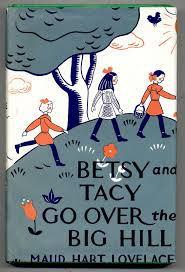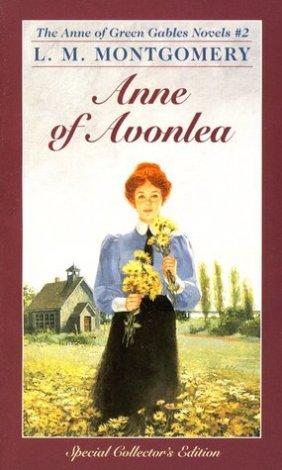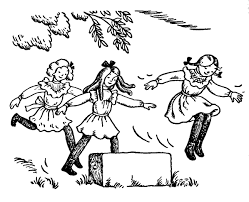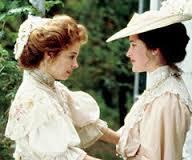

For the Women’s Classics challenge, I’m exploring classic children’s books written by women. In September I read two books, Betsy and Tacy Go Over the Big Hill, and Anne of Avonlea. I had read the first books in the series, but these two were new to me.
The Betsy-Tacy series was written by Maud Hart Lovelace. Lovelace was born in 1892 in Mankato, Minnesota, and the series is written about her own childhood in the very early 1900’s. She attended the University of Minnesota in 1910 and married a reporter in 1917. They had a child, Merian, in 1931 (quite old to have a child at that time). The series was published from 1940 to 1955. Lovelace died in 1980.

Perhaps Lovelace’s books are adored so much because she combines childish innocence and real-life situations. Big Hill involves the children exploring a neighborhood they’ve never been to before, Little Syria, where they befriend a girl who is a Syrian immigrant. I can’t say that this book deals with immigration and race issues in a complex way, but it does address concerns about children teasing someone from another country, using racial slurs, and adults’ general uneasiness with an immigrant community they are not familiar with (Betsy and friends are never told NOT to go to Little Syria, but their parents are clearly uncomfortable with it). It also raises subtler issues like concerns immigrants have regarding assimilation. The Syrian parents think about whether their children should wear Syrian clothing or dress like Americans to blend in. They worry about their children losing their heritage, but they also want to be proud Americans.
So while this book is simplistic, it is written for young children, and I felt it raised issues that are very relevant today, some 75 years after its publication. I also found it an enjoyable read. Betsy and her friends have simple adventures in a fairly innocent world, yet they aren’t perfect children. I particularly enjoyed the part where stubborn Betsy gets into a huge fight with her older sister, and as such things do, the fight gets out of hand, until everyone wishes they could go back in time but no one knows how to end it.
Add to that the beautiful illustrations by Lois Lenski. This was a book I enjoyed reading, even at my advanced age.

The Anne of Green Gables series is written by Lucy Maud Montgomery, and it begins with Anne Shirley as an 11-year-old orphan who is mistakenly sent to live with a family on Prince Edward Island. Anne is notable for her strong opinions, her imagination and idealism, and her insecurity about her red hair and freckles. The series is notable because it was written for adults as well as children, and focuses on the early adult years. The first book, Anne of Green Gables, was published in 1908, and the last book in 1939. Montgomery published many other novels and died in 1942.
Anne of Avonlea is the second book in a series that covers many years of Anne’s life. Anne is sixteen in this book and takes her first job teaching at the local school. She’s an adult in many ways but still childlike in other ways. She wrestles with the idea of falling in love and isn’t quite sure what it means. She also wants to be the perfect teacher and has to learn to temper her expectations of herself. She also sees her childhood friendships change, as they move away, take new jobs, and begin new relationships.
It’s hard to write about this series because I know how beloved these books are. I can see how many girls, growing up without strong female role models in literature, would have adored Anne for all of her strengths and weaknesses. Anne is brave, caring, and a good friend and daughter. She feels like a real person. She’s imaginative and sees magic and wonder everywhere she goes.
At the same time, coming to these books in my 40’s, I can’t fall in love with them the way I know so many women have. I liked many aspects of this book and didn’t care for others. For example, I couldn’t warm to the three children featured in this book, Davy, Dora, and Paul. Paul doesn’t speak like a child, and Anne just seems to go way beyond the bounds of a teacher with him. Davy does things that are really horrible, especially to his sister, and Anne forgives him over and over again.
Children aside, I could really appreciate this story of Anne growing as a new teacher, a friend, a daughter, and a member of a community. I also appreciated Anne’s view of the world – as Anne puts it, she sees her surroundings through poetry rather than prose, in contrast with her friends and family. I’d like to think I see some of both, but I definitely lean more towards the practical side. Or maybe that’s got something to do with getting older. As a child, I would have loved Anne’s creativity and passion, and I would have really related to her insecurities.
As I continue to explore classic children’s literature written by women, I’m heartened to learn about writers like Lovelace and Montgomery, who had such success in their field and produced books that children and adults have loved for years. I’ll also be reading Astrid Lindgren, E. Nesbit, P.L. Travers, Sydney Taylor, and Noel Streatfeild. More information about the Women’s Classic Literature Event can be found here.

